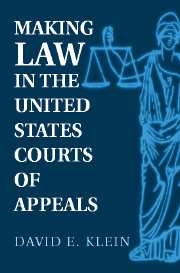Book contents
- Frontmatter
- Contents
- List of Tables
- Acknowledgments
- 1 Law Making in a Hierarchical Judicial System
- 2 Theory and Hypotheses
- 3 The Cases
- 4 Influences on Circuit Judges' Responses: Case Evidence
- 5 Influences on Circuit Judges' Responses: Interview Evidence
- 6 Anticipating the Supreme Court
- 7 Implications and Future Directions
- Appendixes
- References
- Index
4 - Influences on Circuit Judges' Responses: Case Evidence
Published online by Cambridge University Press: 10 December 2009
- Frontmatter
- Contents
- List of Tables
- Acknowledgments
- 1 Law Making in a Hierarchical Judicial System
- 2 Theory and Hypotheses
- 3 The Cases
- 4 Influences on Circuit Judges' Responses: Case Evidence
- 5 Influences on Circuit Judges' Responses: Interview Evidence
- 6 Anticipating the Supreme Court
- 7 Implications and Future Directions
- Appendixes
- References
- Index
Summary
In the preceding chapter we examined how judges react to legal rules announced by colleagues. This chapter takes up the question of why they react as they do. Earlier, I identified four goals that appear to be particularly important to circuit judges' decision making. From them I generated eight hypotheses about the treatment of precedents. The hypotheses are listed in Table 4.1, along with the goal or goals from which each was derived. The primary tests of these hypotheses come from an analysis of the 300 cases described in Chapter 3. I present that analysis and a discussion of its implications in this chapter. In Chapter 5, I return to the interviews, to see what insight the judges can provide.
Before the analysis can begin, the variables to be included in it must be introduced. Several of the key concepts presented tricky issues of measurement, and it would be difficult for the reader to evaluate the results without understanding the methodological choices that were made. Accordingly, taking each measure in turn, I describe the reasoning and decisions involved in its construction. However, a simple statement of coding rules is provided early in each discussion so that those less interested in the methodological issues can move quickly to the results.
MEASURES
Measurement of the dependent variable was described in detail in the preceding chapter. Here it is sufficient to note that favorable treatments of rules (adoptions) are coded as one, unfavorable treatments (rejections) as zero.
- Type
- Chapter
- Information
- Making Law in the United States Courts of Appeals , pp. 62 - 86Publisher: Cambridge University PressPrint publication year: 2002



